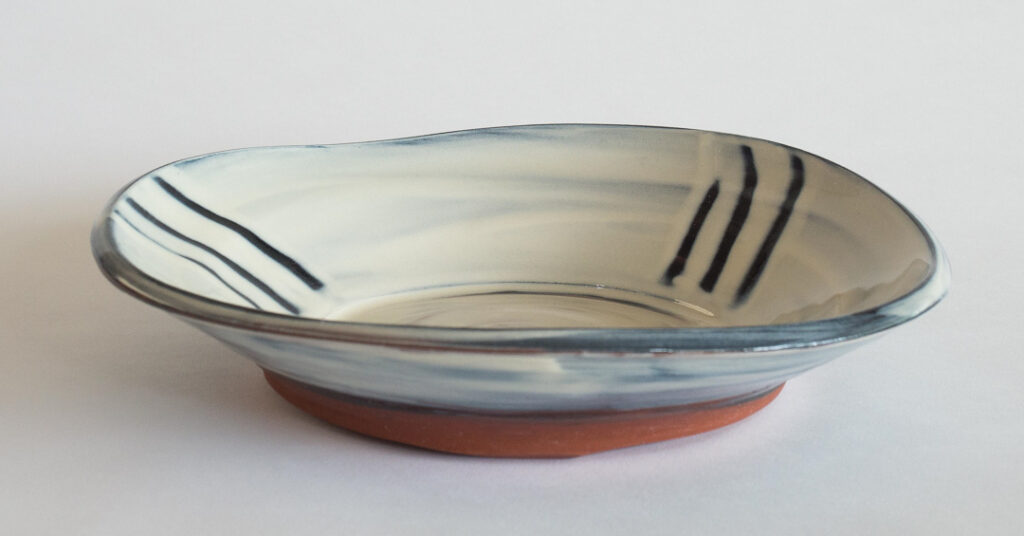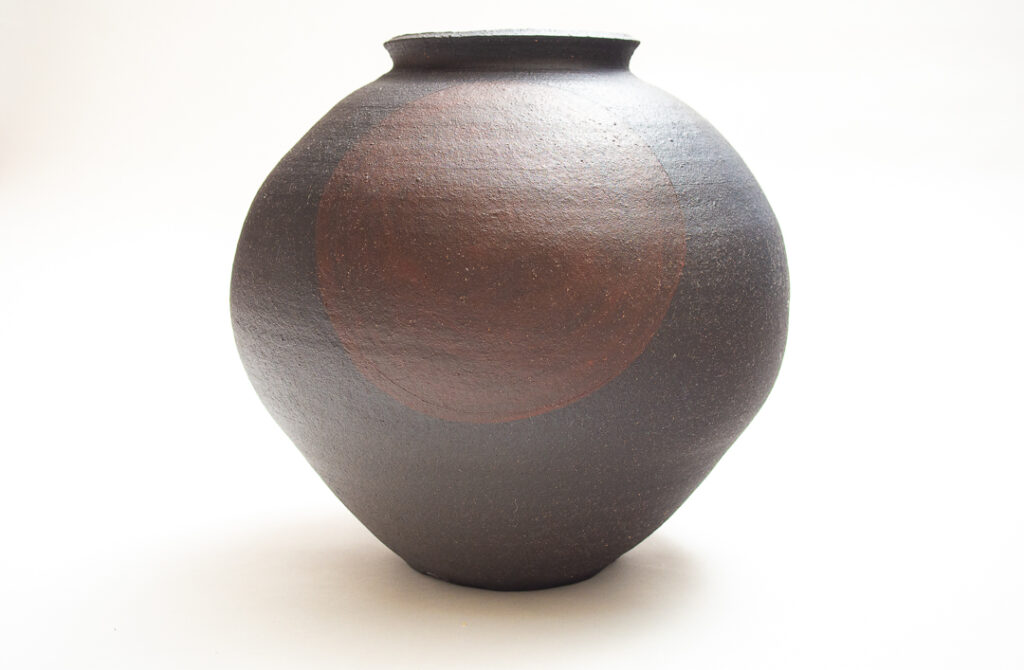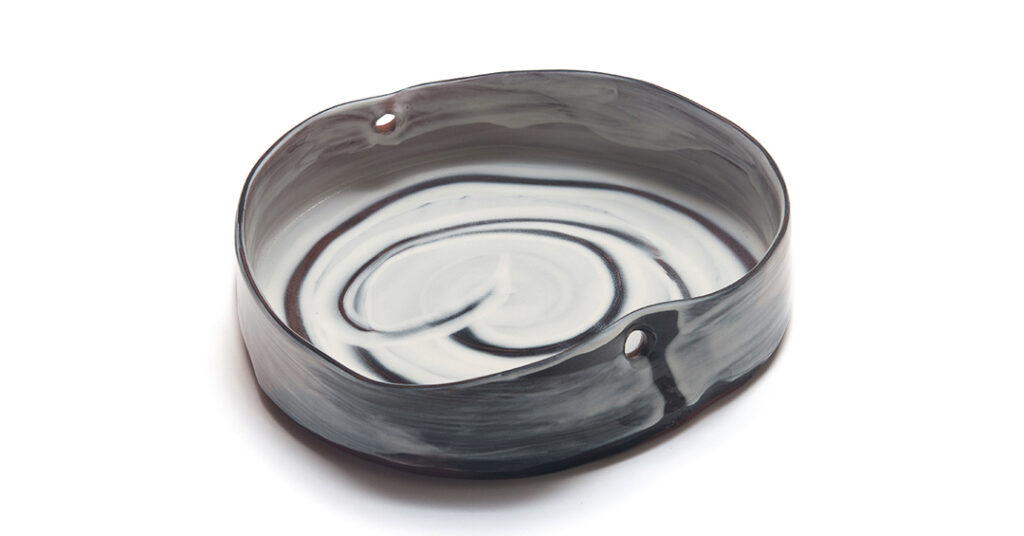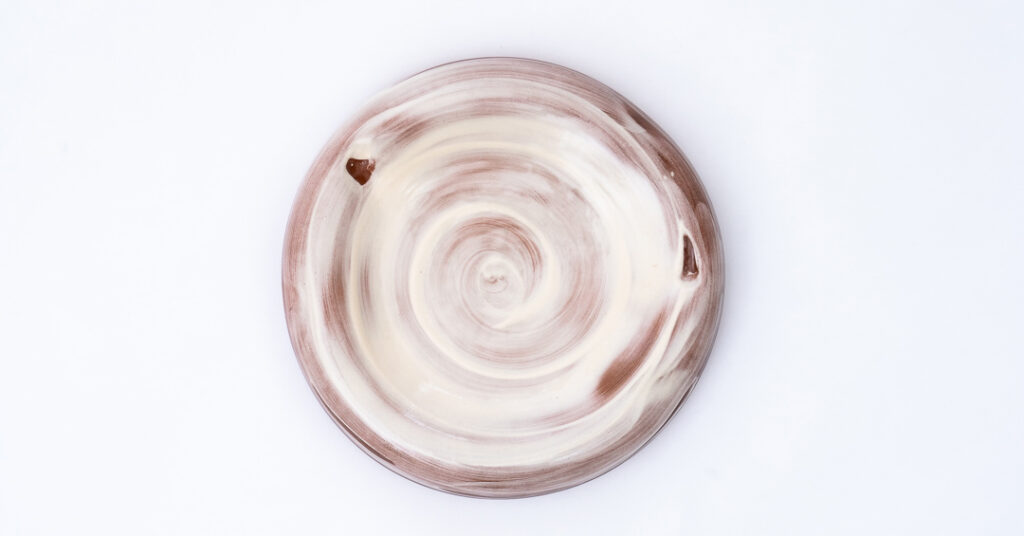
Jane Sawyer, Fluid Series, 2016, red earthenware, pigments, slip, glaze, 37x36x8cms, photo Peter Bonifacio
Now darkness falls,
quail chirps
what use hawk eyes?
Basho
(Sounds of making recorded by Mark Newbound.)
Carolyn Leach-Paholski reflects on the pleasures at hand of a slow ceramics.
One of the first conversations I have with Jane Sawyer about pots concerns a plain Korean rice bowl. This was many years ago, but the memory of it is sharp. The pot is four centuries old, and counting, a treasure from her own collection and yet she allows me to turn it in my hands, put it against my cheek, to hold it to my mouth. In appearance, it is so understated it seems disappointingly obvious. It’s a conundrum, it’s everything and nothing and I’m worried that I won’t get it. Am I bringing my mind to it rather than my heart, I wonder? But the very act of holding it, receiving its shape, flaws, bumps, curves, polish, puts me directly in touch with its maker, my fingers closing around it as his must have close to half a millennia ago. How well the clay remembers his every gesture. How fitting that Jane allows the pot to speak. Now I am listening to the pot’s stories as told to my hands.
To touch is to test, to enjoy, to know. It is as though the mind’s eye manifests in our fingertips. Both the artist and teacher in Jane understand this. She has saved herself an hour or so of talk by putting the pot in my hand. The eye can read an object, but it takes the hand to know it. The eye is easily tricked. It needs points of reference to judge size. It needs light and shadow to read shape. It has really no idea about volume or heft. In darkness, Basho reminds us, what use are hawk eyes?

Jane Sawyer. Blood Moon Falling. 2018. stoneware, terra sigillata. 27x27x30cms, photo Peter Bonifacio
Her own work is irresistibly touchable. Her tableware, made by hand, perfectly fits the hand. Cups do without handles, having dimpled nooks instead. Glazes fix gesture, forever remembering the wheel, the brush, the hand. She tells me that she enjoys making plates, cups and bowls for daily use. And that the use of them day after day gives them poetry and life. The kitchen table is an intimate space but also a theatre. It is domestic, idiosyncratic. It is the centre. Bodies gather, plates pass from hand to hand linking one person to the next, heads draw down to bowls, cups are brought to the lips. The ballet of gestures performed at the table recalls those made at the wheel. Despite the process of hardening, of firing, the poiesis, the making of the object, remains alive in the hand.
✿
When Jane’s grown sons leave home, they each take a set of deep dishes and bowls. Literally and metaphorically, they are still in touch.

Jane Sawyer, Massage Series, 2016, red earthenware, pigments, slip, glaze , 32x33x5.5cms, photo Peter Bonifacio
It seems Jane’s ceramic wall pieces also remember being bowls. They may appear like poems, spare, crafted, but the function is implied. Her Massage series are thrown rather than built. But their bosomy softness depends on technique, a slow wheel, soft clay, an economy of touch. Mounding, centring, opening, pulling up of walls, rounding over the rim: all this is textbook. But everything else departs from common sense. The clay is loaded with water, altering its direction and fluidity. All-of-a-sudden it is remembering being at the bottom of a river. Everything else is momentarily forgotten. What should hold together, pulls apart. It shouldn’t work. Water is chaos, but also freedom, fluidity, freshness. While Jane’s experience and skill marries everything up, it is the wobble that gives the work its living edge, its humanity: the illusion of bodily warmth.

Jane Sawyer, Harvest Moon-red earthenware, terra sigillata, pigments, slip, glaze; photo Peter Bonifacio
Her Pillow series both delights the senses and confounds the brain. How can terracotta which should speak in a mineral-cold voice, be in fact, contralto? How can it convey such softness, that we feel a desire to hold it, or let it hold us? To be cradled by it, to have it pillow a chin or cheek. How can a material of water, kaolin, oxides, the grit and grist of long-dead stars be so alive to the touch?
Again, process and technique shape both the pot and our experience of it. Each piece is wheel-thrown, the walls growing and inclining to become a sphere. The circle doing what a circle wants: to be complete, to enclose air trapped within it, like a sigh. This whimsical, voluminous body of work invites touch and puts us in touch with our sensual selves.
I have the full moon in my house. It hangs in the hall. Every night I walk towards it, tracking into its orbit. I am pulled towards it as I go to bed. During the day its subtle lustre elevates my housework, (such as it is). The Full Moon came from a body of work Jane called Planetary. It was her response to a lunar eclipse. Exhibited alongside: Harvest Moon, Red Planet, Gas Giant, Black Hole and others, most were works hung on the wall and seen from below, as though still spinning through space. Being hung gave them a temporary alignment, as in the phenomena of eclipse. Only Blood Moon Falling (made to reference the Korean moon jar) had indeed fallen to earth. This was exhibited more classically, to be seen in the round, close to, so reachable, touchable as the moon sometimes appears to be.
This week when I was sent for an X-ray of my hands, the radiologist said to me, “hold your hands as though you are carrying a bowl“. Actually, I think on reflection he said, “ball”. But I close my eyes and hold myself as though carrying Jane’s precious Korean rice bowl. Once again, I am in touch with this 400-year-old potter. Again, I am listening to the pot’s stories as told to my hands. “Now bigger”, he says, “much bigger”. I move my hands apart and rotate them until he says to stop. Now in my mind’s eye, I am cradling Full Moon. I can see its white lustre and feel the cool, heavy terracotta. Coaching me from inside his glassed-in booth, he says, “you are a natural, you’re doing well”. But I ask you, who would not want to hold the moon?
About Jane Sawyer
Jane Sawyer is ceramic artist and educator based in Naarm, (Melbourne), Australia. From her studio she produces work for exhibition, limited edition runs, commissions and collaborations. She is the founder of Slow Clay Centre; a facility dedicated to ceramics studies and holds a Masters of Fine Arts by research from RMIT University. She is actively involved in supporting and promoting ceramics and craft and is a member of the International Academy of Ceramics. Visit www.janesawyer.com.au and www.slowclay.com.
The soundtrack that accompanies this writing comes from a film about Jane Sawyer’s work by documentary maker, Mark Newbound. If you listen you can hear touch: clay being wedged, patted on centre, the sticky sound of water, the chattering of the wheel: all the processes of making a pot. There is a trove of Newbound’s beautiful work on Vimeo and Garland. He can be contacted at mark.g.newbound@gmail.com
About Carolyn Leach-Paholski
 Carolyn Leach-Paholski lives in Naarm, (Melbourne) and is a long-time friend of Jane Sawyer. She is a freelance writer and poet. Reach cleachpaholski@gmail.com
Carolyn Leach-Paholski lives in Naarm, (Melbourne) and is a long-time friend of Jane Sawyer. She is a freelance writer and poet. Reach cleachpaholski@gmail.com




Comments
Me encanta leer las historias bien contadas en Garland Magazine.
Ojala muchas personas en América las lean, especialmente los artesanos,
son referencias inspiradoras.
Cada edición de Garland es un regalo Felicito a su Director y
colaboradores. Les agradezco su envío que me hacen en Español.